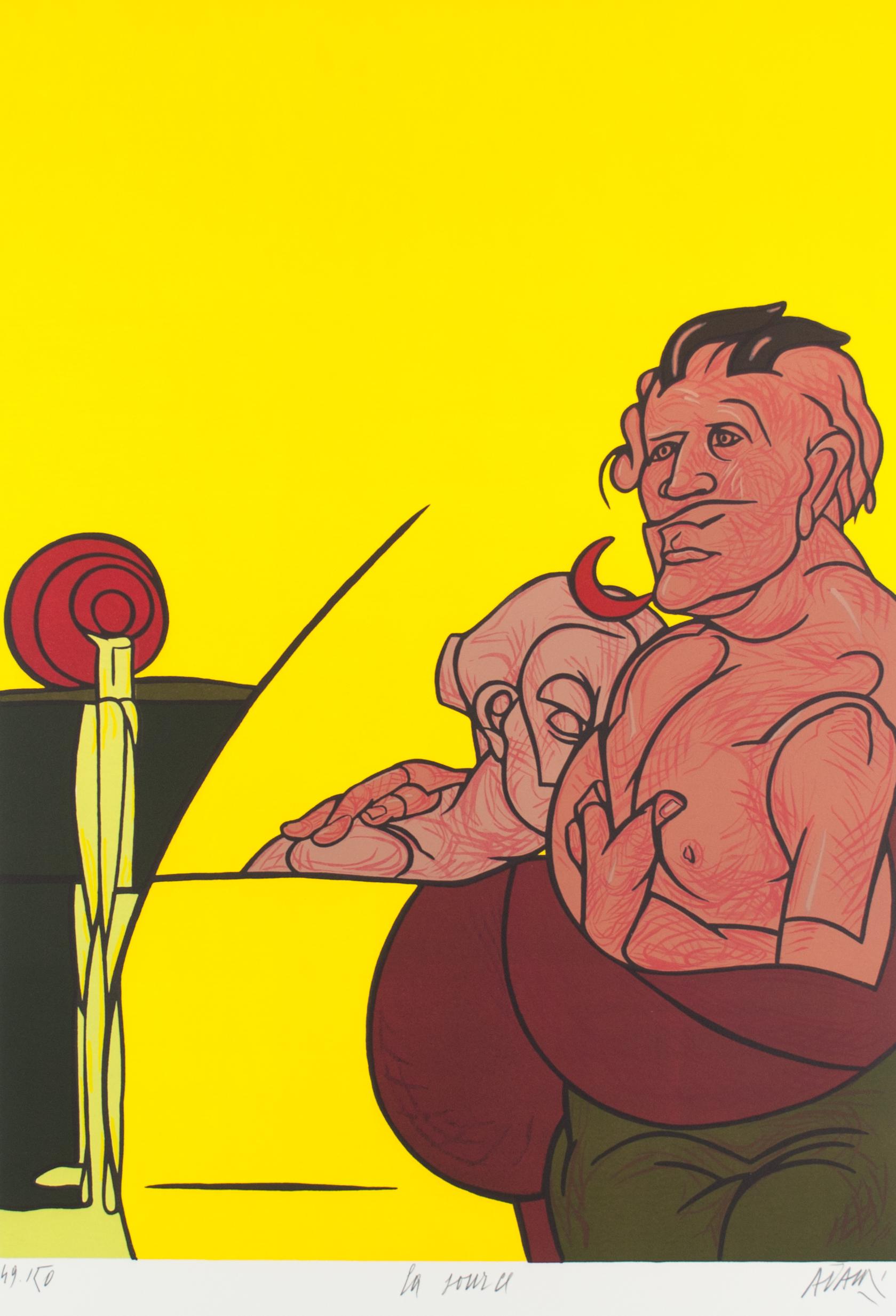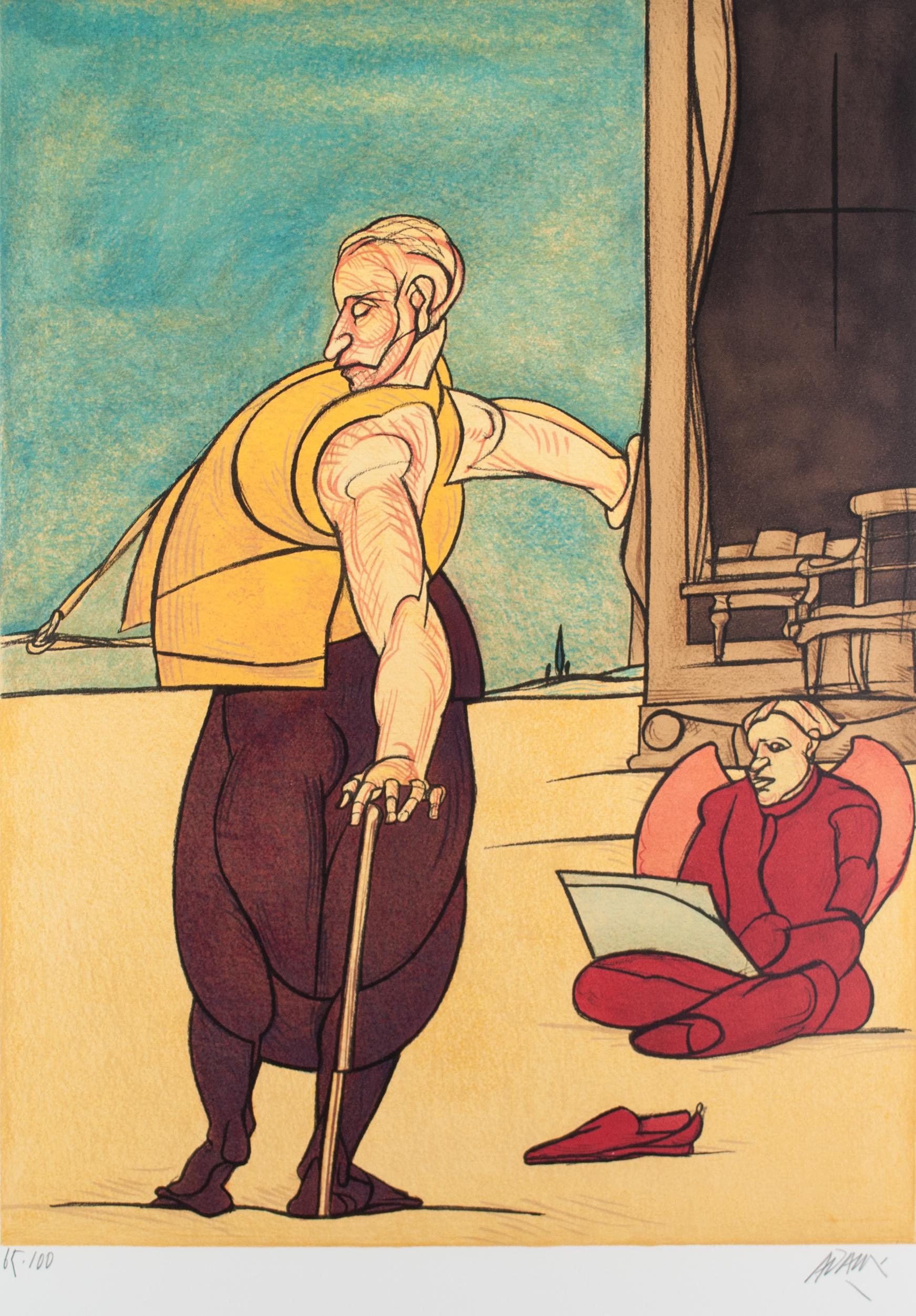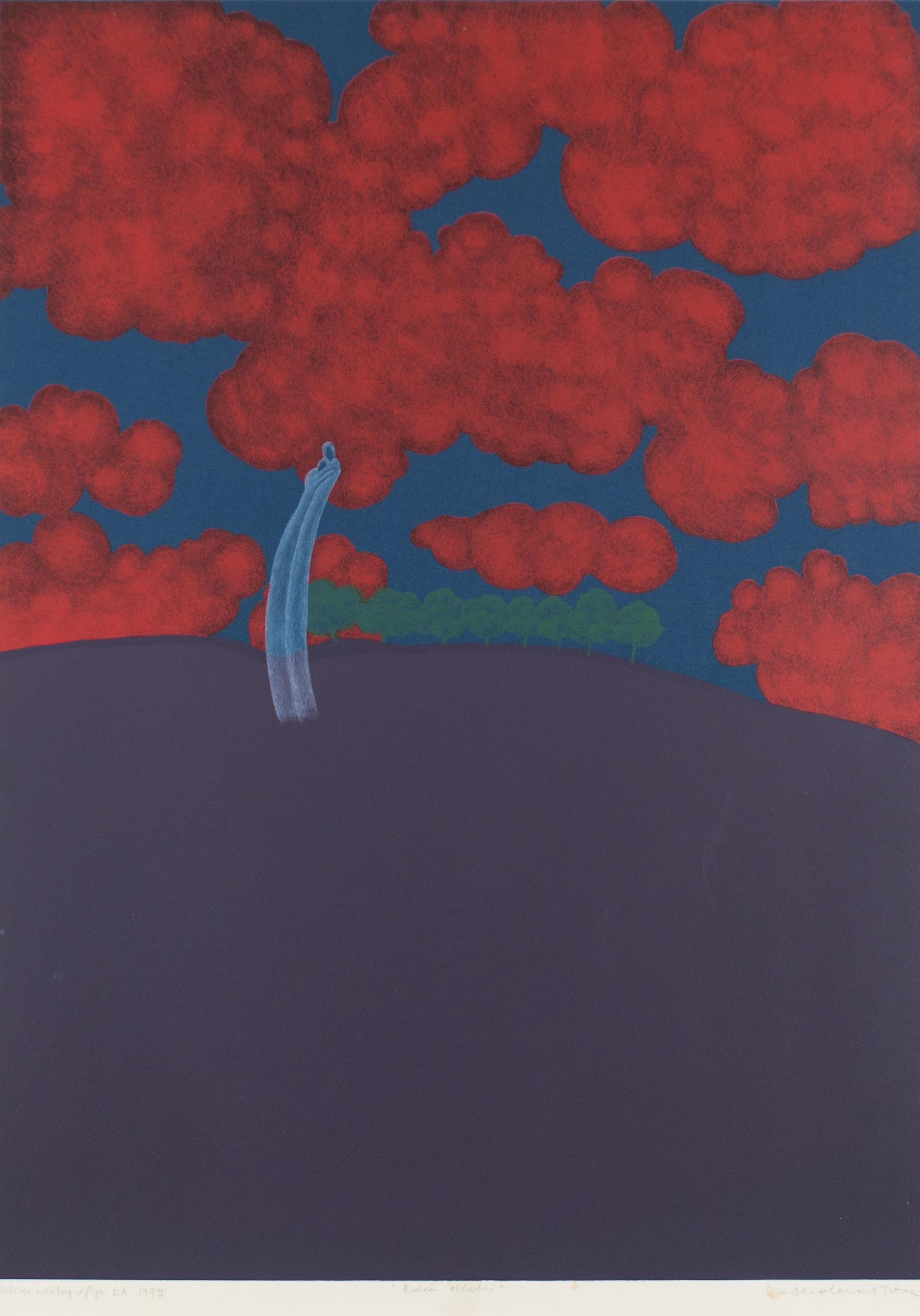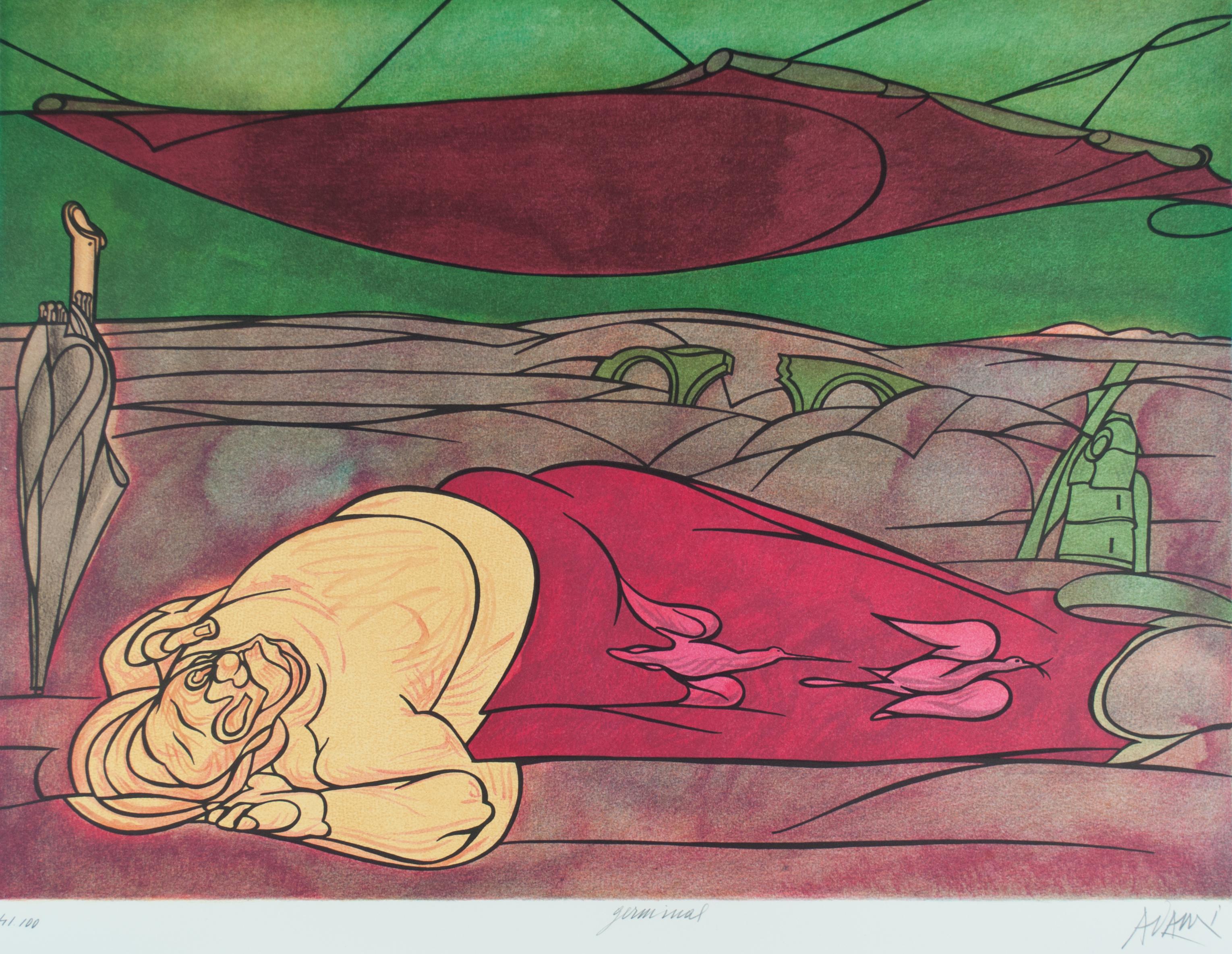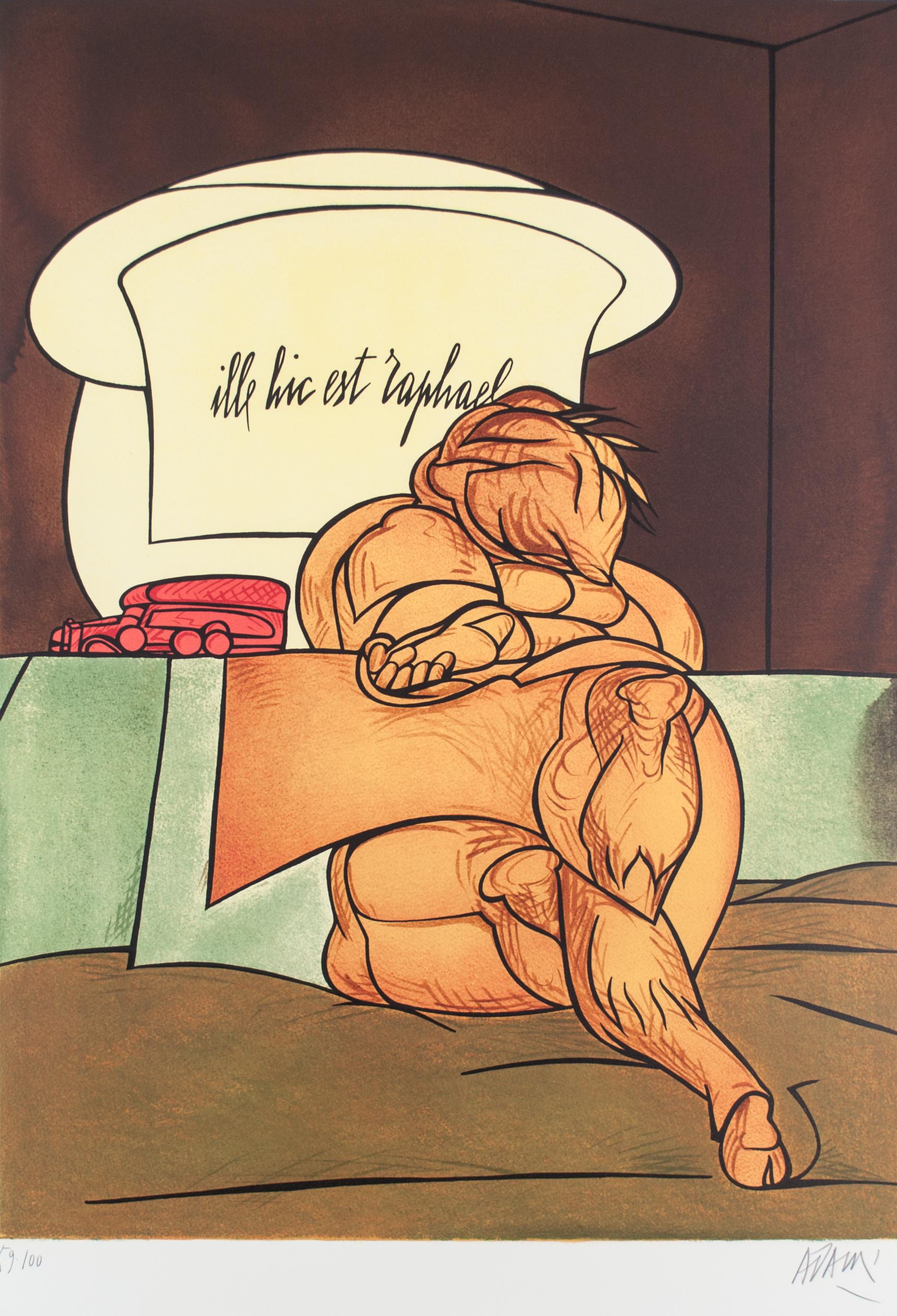Items Similar to The Talmudists Post Soviet Non Conformist Avant Garde Judaica Lithograph
Want more images or videos?
Request additional images or videos from the seller
1 of 8
Alek RapoportThe Talmudists Post Soviet Non Conformist Avant Garde Judaica Lithograph1977
1977
About the Item
Dimensions w/Frame: 18.5 X 14.5
Alek Rapoport (November 24, 1933, Kharkiv, Ukraine SSR – February 4, 1997, San Francisco) was a Russian Nonconformist artist, art theorist and teacher.
Alek Rapoport spent his childhood in Kiev (Ukraine SSR). During Stalin's "purges" both his parents were arrested. His father was shot and his mother spent ten years in a Siberian labor camp. Rapoport lived with his aunt. At the beginning of World War II, he was evacuated to the city of Ufa (the Bashkir Autonomous Soviet Socialist Republic). A time of extreme loneliness, cold, hunger and deprivation, this period also marked the beginning of Rapoport's drawing studies.
After the war, Rapoport lived in Chernovtsy (Western Ukraine), a city with a certain European flair. At the local House of Folk Arts, he found his first art teacher, E.Sagaidachny (1886–1961), a former member of the nonconformist artist groups Union of the Youth (Soyuz Molodyozhi) and Donkey's Tail, popular during the 1910s–1920s. His other art teacher was I. Beklemisheva (1903–1988). Impressed by Rapoport's talent, she later (1950) organized his move to Leningrad, where he entered the famous V.Serov School of Art (the former School of the Imperial Society for the Promotion of Arts, OPKh, later the Tavricheskaya Art School).
His association with this school lasted eight years, first as a student, and then, from 1965 to 1968, as a teacher. With "Socialist realism" the only official style during this time, most of the art school's faculty had to conceal any prior involvement in non-conformist art movements. Ya.K.Shablovsky, V.M.Sudakov, A.A.Gromov introduced their students to Constructivism only through clandestine means.
(1959–1963) Rapoport studied stage design at the Leningrad Institute of Theater, Music and Cinema under the supervision of the famous artist and stage director N.P.Akimov. Akimov taught a unique course based on theories of Russian Suprematism and Constructivism, while encouraging his graduate students to apply their knowledge to every field of art design. Despite differences in personal artistic taste with Akimov, who was drawn to Vermeer and Dalí, Rapoport was influenced by Akimov's personality and liberalism, as well as the logical style of his art.
In 1963, Rapoport graduated from the institute. His highly acclaimed MFA work involved the stage and costume design for I.Babel's play Sunset. In preparation, he traveled to the southwest regions of the Soviet Union, where he accumulated many objects of Judaic iconography from former ghettos, disappearing synagogues and old cemeteries. He wandered Odessa in search of Babel's characters and the atmosphere of his books.
He organized a new liberal course in technical aesthetics, introducing his students to Lotman's theory of semiotics, the Modulor of Le Corbusier, the Bauhaus school, Russian Constructivism, Russian icons and contemporary Western art. As a result of his "radicalism," Rapoport was fired for "ideological conspiracy."
He sought to cultivate himself as Jewish artist. This became particularly noticeable after the Six-Day War, when the Israeli victory led intellectuals, including the Jewish intelligentsia, to feel a heightened interest in Jewish culture and its Biblical roots. Rapoport's works of this period include Three Figures, a series of images of Talmudic Scholars, and works dealing with anti-Semitism. In the 1970s Rapoport joined the non-conformist movement, which opposed the dogmas of "Socialist realism" in art, along with Soviet censorship. The movement sought to preserve the traditions of Russian iconography and the Constructivist/Suprematist style of the 1910s. Despite the authorities' persecutions of nonconformist artists (including arrests, forced evictions, terminations of employment, and various forms of routine hassling), they united in a group, "TEV – Fellowship of Experimental Exhibitions." TEV's exhibitions proved tremendously successful.
In the same period, Rapoport became one of the initiators of another anti-establishment group, ALEF (Union of Leningrad's Jewish Artists). In the United States this group was known as "Twelve from the Soviet Underground." Rapoport's involvement with this group increased tension with the authorities and attracted KGB scrutiny, including "friendly conversations," surveillance, detentions and house arrests. It became increasingly dangerous for him to live and work in the USSR. In October 1976, Rapoport with his wife and son were forced to leave Russia.
In Italy, Rapoport exhibited at the Venice Biennale, "La Nuova Arte Sovietica-Una prospettiva non-ufficiale" (1977), participated in television programs about nonconformist art in the Soviet Union, and created lithographic works continuing his theme of Jewish characters from Babel's play Sunset.
In 1977, Rapoport's family was granted U.S. immigration status and settled in San Francisco. a significant event in Rapoport's life occurred in his meeting with San Francisco gallery owner Michael Dunev, who became his friend and representative, organizing all his exhibitions until the artist's death.
Toward the end of the 1980s and beginning of the 1990s, Rapoport completed his most ambitious works on the theme of the Old Testament prophets: Samson Destroying the House of the Philistines (1989), Lamentation and Mourning and Woe (1990), the four paintings Angel and Prophets (1990–1991) and Three Deeds of Moses (1992).
In 1992, the artist's friends in St. Petersburg organized the first exhibition of his works there since his departure into exile, with works patiently gathered from collectors and art museums. This exhibition, held in the City Museum of St. Petersburg and accompanied by headlines such as "A St. Petersburg artist returns to his town," was followed by much larger ones in 1993 (St. Petersburg and Moscow), organized in collaboration with Michael Dunev Gallery under the name California Branches – Russian Roots.
He Exhibited in "Soviet Artists, Jewish Themes," an exhibit of Nonconformist art of over 40 Jewish artists from the Soviet Union.
The variety of Jewish themes range from rural, village scenes to images of the Holocaust, to mystical interpretations based on Kabbalistic texts by artists such as Grisha Bruskin, Anatolii Kaplan, Vitaly Komar, Alexander Melamid, Leonid Lamm, Dmitrii Lion, and Alek Rapoport.
The exhibit focused on the work of Jewish artist in times of social oppression and were created in private, and were mostly kept hidden from the public eye.
Main personal exhibitions
1980 – Gallerie "Trifalco," Rome, Italy
1981 – Images of San Francisco, Eduard Nakhamkin Gallery, New York, NY.
1984 – Images of San Francisco, University of the Pacific Gallery, Stockton, CA.
1986 – Images of San Francisco, Michael Dunev Gallery, San Francisco, CA.
1988 – Ecumenical Works, Michael Dunev Gallery, San Francisco, CA.
1992 – Russia-USA, The Museum of the City of St. Petersburg, St. Petersburg, Russia.
1993 – California Branches-Russian Roots, Manege Exhibition Hall, St. Petersburg, Russia; National Exhibition Hall, Moscow, Russia.
1996 – Ecumenical Paintings, SOMAR Gallery, San Francisco, CA.
1997 – The Last Paintings: A Memorial Exhibition, Michael Dunev Gallery, San Francisco, CA; The Early Drawings. A Memorial Exhibition. George Krevsky Fine Art, San Francisco, CA; Sacred Inspiration: Icons by Alek Rapoport, The Marian Library, IMRI, Dayton University, Dayton, OH.[14]
1998 – Angel and Prophet, Center for Art and Religion, Washington, DC.
2004 – Images of San Francisco, Diaghilev Art Center, St. Petersburg, Russia.
2007 – Alek Rapoport: A Memorial Exhibition, Belcher Studios Gallery, San Francisco, CA.
- Creator:Alek Rapoport (1933, Russian)
- Creation Year:1977
- Dimensions:Height: 18.5 in (46.99 cm)Width: 14.5 in (36.83 cm)
- Medium:
- Movement & Style:
- Period:
- Condition:paper has light toning. minor crack to far corner of glass.
- Gallery Location:Surfside, FL
- Reference Number:1stDibs: LU38213001682
About the Seller
4.9
Platinum Seller
These expertly vetted sellers are 1stDibs' most experienced sellers and are rated highest by our customers.
Established in 1995
1stDibs seller since 2014
1,547 sales on 1stDibs
Typical response time: 1 hour
- ShippingRetrieving quote...Ships From: Surfside, FL
- Return PolicyA return for this item may be initiated within 3 days of delivery.
More From This SellerView All
- Lithograph Screenprint Male Heroic FiguresBy Ernst NeizvestnyLocated in Surfside, FLErnst Iosifovich Neizvestny (Russian: Эрнст Ио́сифович Неизве́стный) (born 1925) is a Russian sculptor. He lives and works in New York City. Non Conformist Post Soviet Avant Garde Neizvestny was born 9 April 1925 in Sverdlovsk (now Yekaterinburg). In 1942, at the age of 17, he joined the Red Army as a volunteer. At the close of World War II, he was heavily wounded and sustained a clinical death. Although he was awarded the Order of the Red Star and his mother received an official notification that her son had died, Neizvestny managed to survive. In 1947, Neizvestny was enrolled at the Art Academy of Latvia in Riga. He continued his education at the Surikov Moscow Art Institute and the Philosophy Department of the Moscow State University. His sculptures, often based on the forms of the human body, are noted for their expressionism and powerful plasticity. Although his preferred material is bronze, his larger, monumental installations are often executed in concrete. Most of his works are arranged in extensive cycles, the best known of which is The Tree of Life, a theme he has developed since 1956. Art career Although Nikita Khrushchev...Category
20th Century Post-Modern Figurative Prints
MaterialsLithograph
- The Rabbi 1977 Soviet Non Conformist Avant Garde PrintBy Alek RapoportLocated in Surfside, FLDimensions w/Frame: 25 3/4" x 20 3/4" Alek Rapoport (November 24, 1933, Kharkiv, Ukraine SSR – February 4, 1997, San Francisco) was a Russian Nonconformist artist, art theorist and teacher. Alek Rapoport spent his childhood in Kiev (Ukraine SSR). During Stalin's "purges" both his parents were arrested. His father was shot and his mother spent ten years in a Siberian labor camp. Rapoport lived with his aunt. At the beginning of World War II, he was evacuated to the city of Ufa (the Bashkir Autonomous Soviet Socialist Republic). A time of extreme loneliness, cold, hunger and deprivation, this period also marked the beginning of Rapoport's drawing studies. After the war, Rapoport lived in Chernovtsy (Western Ukraine), a city with a certain European flair. At the local House of Folk Arts, he found his first art teacher, E.Sagaidachny (1886–1961), a former member of the nonconformist artist groups Union of the Youth (Soyuz Molodyozhi) and Donkey's Tail, popular during the 1910s–1920s. His other art teacher was I. Beklemisheva (1903–1988). Impressed by Rapoport's talent, she later (1950) organized his move to Leningrad, where he entered the famous V.Serov School of Art (the former School of the Imperial Society for the Promotion of Arts, OPKh, later the Tavricheskaya Art School). His association with this school lasted eight years, first as a student, and then, from 1965 to 1968, as a teacher. With "Socialist realism" the only official style during this time, most of the art school's faculty had to conceal any prior involvement in non-conformist art movements. Ya.K.Shablovsky, V.M.Sudakov, A.A.Gromov introduced their students to Constructivism only through clandestine means. (1959–1963) Rapoport studied stage design at the Leningrad Institute of Theater, Music and Cinema under the supervision of the famous artist and stage director N.P.Akimov. Akimov taught a unique course based on theories of Russian Suprematism and Constructivism, while encouraging his graduate students to apply their knowledge to every field of art design. Despite differences in personal artistic taste with Akimov, who was drawn to Vermeer and Dalí, Rapoport was influenced by Akimov's personality and liberalism, as well as the logical style of his art. In 1963, Rapoport graduated from the institute. His highly acclaimed MFA work involved the stage and costume design for I.Babel's play Sunset. In preparation, he traveled to the southwest regions of the Soviet Union, where he accumulated many objects of Judaic iconography from former ghettos, disappearing synagogues and old cemeteries. He wandered Odessa in search of Babel's characters and the atmosphere of his books. He organized a new liberal course in technical aesthetics, introducing his students to Lotman's theory of semiotics, the Modulor of Le Corbusier, the Bauhaus school, Russian Constructivism, Russian icons and contemporary Western art. As a result of his "radicalism," Rapoport was fired for "ideological conspiracy." He sought to cultivate himself as Jewish artist. This became particularly noticeable after the Six-Day War, when the Israeli victory led intellectuals, including the Jewish intelligentsia, to feel a heightened interest in Jewish culture and its Biblical roots. Rapoport's works of this period include Three Figures, a series of images of Talmudic Scholars, and works dealing with anti-Semitism. In the 1970s Rapoport joined the non-conformist movement, which opposed the dogmas of "Socialist realism" in art, along with Soviet censorship. The movement sought to preserve the traditions of Russian iconography and the Constructivist/Suprematist style of the 1910s. Despite the authorities' persecutions of nonconformist artists (including arrests, forced evictions, terminations of employment, and various forms of routine hassling), they united in a group, "TEV – Fellowship of Experimental Exhibitions." TEV's exhibitions proved tremendously successful. In the same period, Rapoport became one of the initiators of another anti-establishment group, ALEF (Union of Leningrad's Jewish Artists). In the United States this group was known as "Twelve from the Soviet Underground." Rapoport's involvement with this group increased tension with the authorities and attracted KGB scrutiny, including "friendly conversations," surveillance, detentions and house arrests. It became increasingly dangerous for him to live and work in the USSR. In October 1976, Rapoport with his wife and son were forced to leave Russia. In Italy, Rapoport exhibited at the Venice Biennale, "La Nuova Arte Sovietica-Una prospettiva non-ufficiale" (1977), participated in television programs about nonconformist art in the Soviet Union, and created lithographic works continuing his theme of Jewish characters from Babel's play Sunset. In 1977, Rapoport's family was granted U.S. immigration status and settled in San Francisco. a significant event in Rapoport's life occurred in his meeting with San Francisco gallery owner Michael Dunev, who became his friend and representative, organizing all his exhibitions until the artist's death. Toward the end of the 1980s and beginning of the 1990s, Rapoport completed his most ambitious works on the theme of the Old Testament prophets: Samson Destroying the House of the Philistines (1989), Lamentation and Mourning and Woe (1990), the four paintings Angel and Prophets (1990–1991) and Three Deeds of Moses (1992). In 1992, the artist's friends in St. Petersburg organized the first exhibition of his works there since his departure into exile, with works patiently gathered from collectors and art museums. This exhibition, held in the City Museum of St. Petersburg and accompanied by headlines such as "A St. Petersburg artist returns to his town," was followed by much larger ones in 1993 (St. Petersburg and Moscow), organized in collaboration with Michael Dunev Gallery under the name California Branches – Russian Roots. He Exhibited in "Soviet Artists, Jewish Themes...Category
1970s Post-Modern Figurative Prints
MaterialsLithograph
- 1970 Silencio, Direccion Unica, One Way Spanish Political Etching Pop Art PrintBy Juan GenovesLocated in Surfside, FLJuan Genovés Candel (Spanish, 1930-) Painter, illustrator, and graphic printmaker engraver. He painted 'El abrazo' ('the embrace'), which became an emblematic poster during the Spanish political transition. He was born in Valencia in 1930. The son of Juan Genovés Cubells, an artisan whose family was close to the labor movement. His mother Maria Candel Muñoz came from a family of practicing Catholics. In 1946 Genovés studied at the Escuela de Bellas Artes de San Carlos in Valencia and then settled in Madrid. He set up the 'Los Siete' group together with other artists in 1949, and the following year he travelled to Madrid, where he was influenced by the works by Fra Angélico and Hieronymus Bosch in the Prado Museum. In 1957 he had his first solo exhibitions in the gallery Alfil, Madrid and in the Museo d'Arte Moderna, Havana. He is considered the most important representative of modern Spanish painting. His images, executed in a politically engaged, critical realism...Category
1970s Pop Art Figurative Prints
MaterialsLithograph
- Malcolm Morley 1969 Vintage British Pop Art Screenprint Lithograph Marine w FlagBy Malcolm MorleyLocated in Surfside, FLMalcolm Morley (British, b. 1931) Silkscreen screenprint Title: Marine Sergeant at Valley Forge Hand signed lower right. on BFK Rives paper. Provenance: Estate of Roger Prigent - Malmaison. (from Kornblee Gallery, photo of label but label is not included) Image: 19 1/4"H x 16" W; Sheet: 30 1/4"H x 22 1/2" W. Printer: Chiron Press (New York, NY) Date: 1969 Malcolm Morley (1931-2018) is an English artist now living in the United States. He is best known as a photorealist. Morley was born in north London. He had a troubled childhood—after his home was blown up by a bomb during the Blitz in World War II, his family was homeless for a time—and did not discover art until serving a three-year stint in Wormwood Scrubs prison. After release, he studied art first at the Camberwell School of Arts and then at the Royal College of Art (1955–1957), where his fellow students included Peter Blake and Frank Auerbach. In 1956, he saw an exhibition of contemporary American art at the Tate Gallery, and began to produce paintings in an abstract expressionist style. In the mid 1960s, Morley briefly taught at Ohio State University, and then moved back to New York City, where he taught at SUNY Stony Brook from 1970 through 1974 and the School of Visual Arts. In the early 1980s he was married to the Brazilian artist Marcia Grostein...Category
21st Century and Contemporary Pop Art Figurative Prints
MaterialsLithograph, Screen
- Large Color French Cubist Lithograph Tree of Life Signed Ltd Ed. Sculpture StudyBy Jacques LipchitzLocated in Surfside, FLChaim Jacob Lipchitz, 1891-1973, was born in Lithuania and came of age in Paris during the early 20th century, where he was active in the avante-garde community of Pablo Picasso, Ama...Category
1970s Cubist Figurative Prints
MaterialsLithograph
- Large French Judaica Lithograph Carborundum Etching Jewish Hebrew EmbossingBy Théo TobiasseLocated in Surfside, FLTheo Tobiasse Suite: Shavuot Festival Year: 1984 Medium: Original carborundum embossed etching lithograph in colors on Arches paper (deckle edged paper) Signature: Hand signed by the artist Publisher Nahan Gallery, New Orleans Theo Tobiasse, born Tobias Eidesas, 1927 in Jaffa then in British Mandate Palestine, died 2012 in Cagnes-sur-Mer in France. Well known painter, engraver, draftsman and sculptor. French Jewish artist. The youngest son of Chaim (Charles) Eidesas and Brocha (Berthe) Slonimsky from Kaunas, Lithuania, Théo Tobiasse was born in Mandatory Palestine in 1927, where his Jewish parents lived since 1925, far from the threat of pogroms and upheavals of East European policies. The family encountered material difficulties and decided to return to Lithuania, ultimately leaving for Paris in 1931 where his father typographer finds work in a Russian printing press. Theodore Tobiasse...Category
1970s Modern Figurative Prints
MaterialsEtching, Lithograph
You May Also Like
- Jungle IBy Niki de Saint PhalleLocated in Ljubljana, SIJungle I. Original color litograph, unknown year. Niki de Saint Phalle was a French-American naive artist, a sculptor, painter and filmmaker, also known...Category
Late 20th Century Post-Modern Figurative Prints
MaterialsLithograph
- La sourceBy Valerio AdamiLocated in Ljubljana, SILa Source. Original color lithograph, 1984. Edition of 150 signed and numbered impressions on Arches paper. Published by Galerie Maeght-Lelong in Paris, France. Adami Valerio...Category
1980s Post-Modern Figurative Prints
MaterialsLithograph
- AngélusBy Valerio AdamiLocated in Ljubljana, SIAngélus. Original color lithograph, 1982. Edition of 100 signed and numbered impressions on Arches paper. Published in Paris by Galerie Maeght-Lelong. Valerio Adami is an Italian art...Category
1980s Post-Modern Figurative Prints
MaterialsLithograph
- Red cloudsLocated in Ljubljana, SIRdeči oblaki (eng. Red clouds). Original color silkscreen and lithograph, 1975. Edition of E.A. (artist’s proof) signed and numbered impressions on Arches paper. Metka Krašovec...Category
1970s Post-Modern Figurative Prints
MaterialsLithograph, Screen
- GerminalBy Valerio AdamiLocated in Ljubljana, SIGerminal. Original color lithograph, 1983. Edition of 100 signed and numbered impressions on Arches paper. Valerio Adami is an Italian artist knows for his Nouvelle Figuration moveme...Category
1980s Post-Modern Figurative Prints
MaterialsLithograph
- Ille hic est Raphael (L’urne)By Valerio AdamiLocated in Ljubljana, SIIlle hic est Raphael (L’urne). Original color lithograph, 1983. Edition of 100 signed and numbered impressions on Arches paper. Valerio Adami is an Italian artist knows for his Nouve...Category
1980s Post-Modern Figurative Prints
MaterialsLithograph

